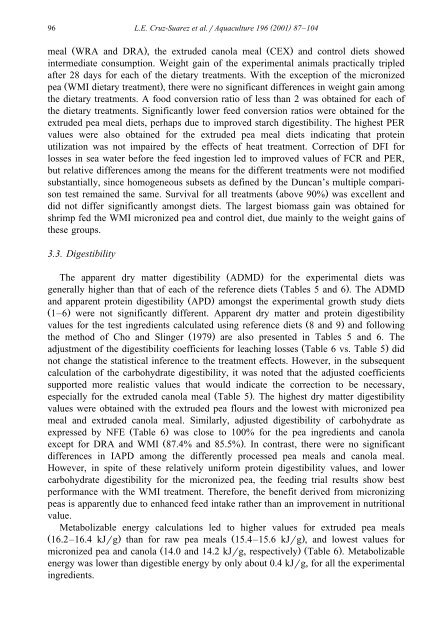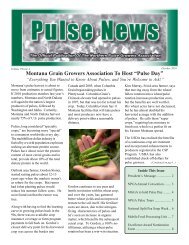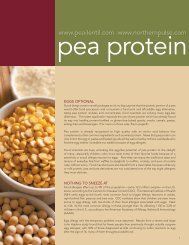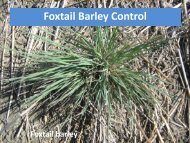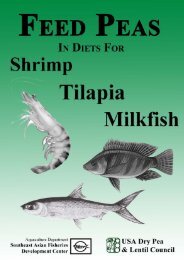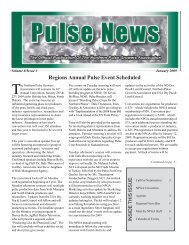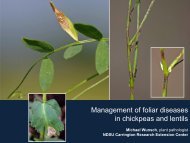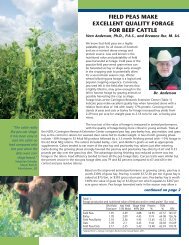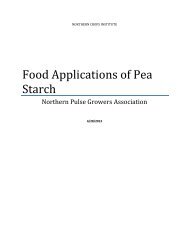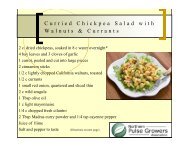Processed feed pea and canola meal for blue shrimp diets
Processed feed pea and canola meal for blue shrimp diets
Processed feed pea and canola meal for blue shrimp diets
You also want an ePaper? Increase the reach of your titles
YUMPU automatically turns print PDFs into web optimized ePapers that Google loves.
96<br />
( )<br />
L.E. Cruz-Suarez et al.rAquaculture 196 2001 87–104<br />
<strong>meal</strong> Ž WRA <strong>and</strong> DRA ., the extruded <strong>canola</strong> <strong>meal</strong> Ž CEX.<br />
<strong>and</strong> control <strong>diets</strong> showed<br />
intermediate consumption. Weight gain of the experimental animals practically tripled<br />
after 28 days <strong>for</strong> each of the dietary treatments. With the exception of the micronized<br />
<strong>pea</strong> Ž WMI dietary treatment ., there were no significant differences in weight gain among<br />
the dietary treatments. A food conversion ratio of less than 2 was obtained <strong>for</strong> each of<br />
the dietary treatments. Significantly lower <strong>feed</strong> conversion ratios were obtained <strong>for</strong> the<br />
extruded <strong>pea</strong> <strong>meal</strong> <strong>diets</strong>, perhaps due to improved starch digestibility. The highest PER<br />
values were also obtained <strong>for</strong> the extruded <strong>pea</strong> <strong>meal</strong> <strong>diets</strong> indicating that protein<br />
utilization was not impaired by the effects of heat treatment. Correction of DFI <strong>for</strong><br />
losses in sea water be<strong>for</strong>e the <strong>feed</strong> ingestion led to improved values of FCR <strong>and</strong> PER,<br />
but relative differences among the means <strong>for</strong> the different treatments were not modified<br />
substantially, since homogeneous subsets as defined by the Duncan’s multiple comparison<br />
test remained the same. Survival <strong>for</strong> all treatments Ž above 90% . was excellent <strong>and</strong><br />
did not differ significantly amongst <strong>diets</strong>. The largest biomass gain was obtained <strong>for</strong><br />
<strong>shrimp</strong> fed the WMI micronized <strong>pea</strong> <strong>and</strong> control diet, due mainly to the weight gains of<br />
these groups.<br />
3.3. Digestibility<br />
The apparent dry matter digestibility Ž ADMD.<br />
<strong>for</strong> the experimental <strong>diets</strong> was<br />
generally higher than that of each of the reference <strong>diets</strong> Ž Tables 5 <strong>and</strong> 6 .. The ADMD<br />
<strong>and</strong> apparent protein digestibility Ž APD.<br />
amongst the experimental growth study <strong>diets</strong><br />
Ž 1–6.<br />
were not significantly different. Apparent dry matter <strong>and</strong> protein digestibility<br />
values <strong>for</strong> the test ingredients calculated using reference <strong>diets</strong> Ž 8 <strong>and</strong> 9.<br />
<strong>and</strong> following<br />
the method of Cho <strong>and</strong> Slinger Ž 1979.<br />
are also presented in Tables 5 <strong>and</strong> 6. The<br />
adjustment of the digestibility coefficients <strong>for</strong> leaching losses Ž Table 6 vs. Table 5.<br />
did<br />
not change the statistical inference to the treatment effects. However, in the subsequent<br />
calculation of the carbohydrate digestibility, it was noted that the adjusted coefficients<br />
supported more realistic values that would indicate the correction to be necessary,<br />
especially <strong>for</strong> the extruded <strong>canola</strong> <strong>meal</strong> Ž Table 5 .. The highest dry matter digestibility<br />
values were obtained with the extruded <strong>pea</strong> flours <strong>and</strong> the lowest with micronized <strong>pea</strong><br />
<strong>meal</strong> <strong>and</strong> extruded <strong>canola</strong> <strong>meal</strong>. Similarly, adjusted digestibility of carbohydrate as<br />
expressed by NFE Ž Table 6.<br />
was close to 100% <strong>for</strong> the <strong>pea</strong> ingredients <strong>and</strong> <strong>canola</strong><br />
except <strong>for</strong> DRA <strong>and</strong> WMI Ž 87.4% <strong>and</strong> 85.5% .. In contrast, there were no significant<br />
differences in IAPD among the differently processed <strong>pea</strong> <strong>meal</strong>s <strong>and</strong> <strong>canola</strong> <strong>meal</strong>.<br />
However, in spite of these relatively uni<strong>for</strong>m protein digestibility values, <strong>and</strong> lower<br />
carbohydrate digestibility <strong>for</strong> the micronized <strong>pea</strong>, the <strong>feed</strong>ing trial results show best<br />
per<strong>for</strong>mance with the WMI treatment. There<strong>for</strong>e, the benefit derived from micronizing<br />
<strong>pea</strong>s is apparently due to enhanced <strong>feed</strong> intake rather than an improvement in nutritional<br />
value.<br />
Metabolizable energy calculations led to higher values <strong>for</strong> extruded <strong>pea</strong> <strong>meal</strong>s<br />
Ž 16.2–16.4 kJrg. than <strong>for</strong> raw <strong>pea</strong> <strong>meal</strong>s Ž 15.4–15.6 kJrg ., <strong>and</strong> lowest values <strong>for</strong><br />
micronized <strong>pea</strong> <strong>and</strong> <strong>canola</strong> Ž 14.0 <strong>and</strong> 14.2 kJrg, respectively. Ž Table 6 .. Metabolizable<br />
energy was lower than digestible energy by only about 0.4 kJrg, <strong>for</strong> all the experimental<br />
ingredients.


